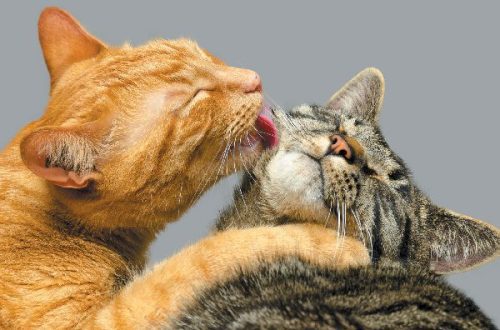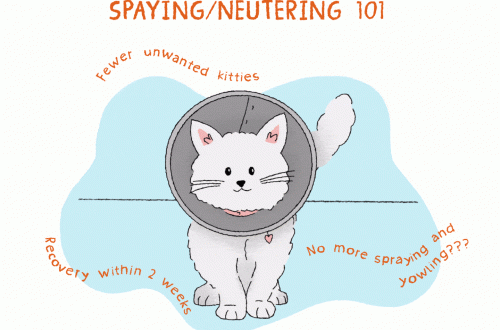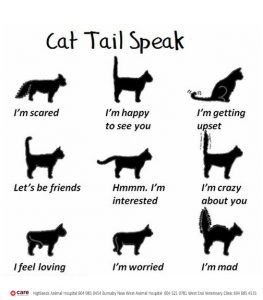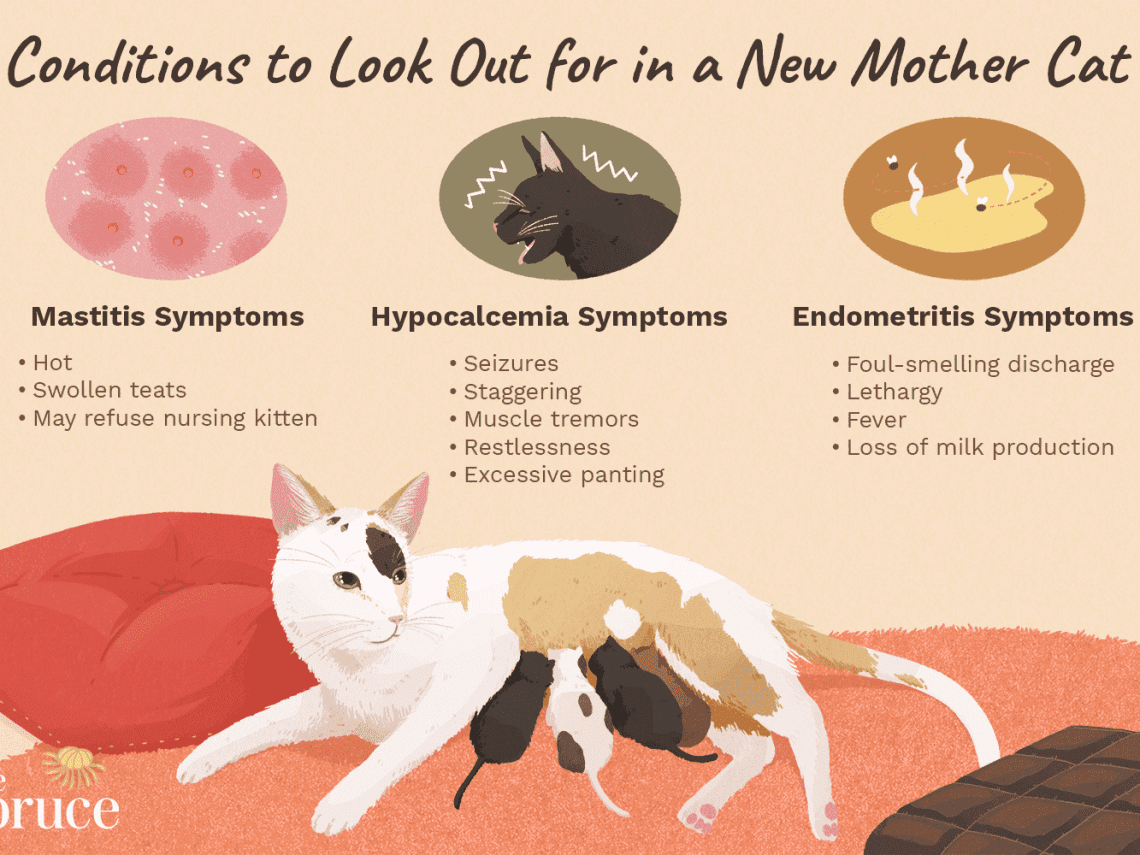
Childbirth in a cat: signs, preparation, care after childbirth
Despite the fact that the birth of a cat is a natural process, the owner of the animal will have a lot of trouble. A cat living at home needs to create a special environment for the birth of offspring, provide veterinary care if necessary, “meet” new residents and make sure that they and the mustachioed mother have enough food.
Contents
- Signs of incipient labor
- Preparing for childbirth
- How do cats give birth?
- Features of the first birth
- Problems that may arise during the birth of a cat
- In what cases should you urgently contact a veterinarian
- How to know if all the kittens were born
- End of childbirth
- How to care for a cat after childbirth
- postpartum problems
- Is it possible to sterilize a cat during childbirth
Signs of incipient labor
Pregnancy in cats lasts, on average, 60 days. But since each organism is individual, it is not possible to predict the exact date of the upcoming birth, even if the pet was brought together with a cat purposefully.
The most informative indicator is the following fact: before the birth begins, the cat’s water and cork leave. It can be problematic to detect this phenomenon in time, since the expectant mother will lick herself, and not every owner can always be near her. Therefore, you need to pay attention to other signs of an approaching delivery:
- in a day or two, the mammary glands of a cat increase in volume, colostrum is released;
- the behavior of the pet changes – it becomes indifferent to food, meows a lot, can show aggression and hide, or, on the contrary, follow the owner on the heels;
- a few days before the birth, the expectant mother is looking for a secluded place suitable for this;
- the cat often licks the stomach, genitals;
- there is a decrease in the body temperature of the pet;
- approximately 5 hours before delivery, the animal’s spine acquires a characteristic curve.
Preparing for childbirth
You need to prepare thoroughly for childbirth. This will require not only to equip the place where the kittens will appear, but also to prepare some tools and materials that may be required in case of complications. In addition, you should take care to have medicines on hand and be sure to write down the phone number of the veterinarian so that you can contact him at any time.
Arrangement of the “nest”
For the temporary habitation of the mother and offspring, a large box is perfect. To make it easier for the cat to climb into it, one side can be made lower than the rest. It is not recommended to make a slot along the entire height of the box in order to prevent the kittens from “escape”.
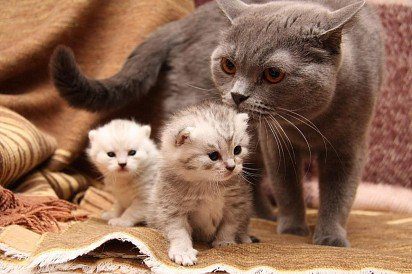
Mother cat with her kittens
The bottom of the box can be covered with a rubber or foam mat, or a piece of similar material, oilcloth. This will protect the cardboard from accidental getting wet. A cloth or disposable diaper is placed on top.
It is desirable that the box should be in the place that the cat has chosen, but, in most cases, mustachioed mothers prefer closets or the owner’s bed. The place where the box will stand should be quiet, warm, secluded. It is necessary to accustom the pet to the “nest” gradually, putting water for drinking and food nearby. In the end, she will understand what is required of her, and will accept the proposed option.
Preparation of tools
By the time of childbirth, items that may be needed should be prepared if the situation takes an unexpected turn:
- scissors;
- sterile rubber gloves;
- Vaseline oil;
- antiseptic (brilliant green);
- syringe;
- dishes for clean water;
- cotton buds;
- thread;
- syringes of different sizes;
- disposable diapers;
- pieces of cotton fabric (they must first be washed and ironed).
All accessories must be in one place and in “combat readiness”: be clean, disinfected.
Medications
In some cases, a mustachioed pet may need medical assistance, so in addition to tools, some medicines should be prepared.
- Oxytocin. It will help with the sudden cessation of contractions or weak labor activity. Promotes contraction of the walls of the uterus. Applied as an injection into the withers at a dosage of 0,2 ml.
- Travmatin. As soon as the labor begins in the laboring woman, you can give an injection of this drug at a dosage of 1 ml. After the end of childbirth, the remedy is used for the next three days, one injection per day. Travmatin eliminates pain, prevents the development of the inflammatory process, has an antimicrobial effect, and reduces the likelihood of infectious complications.
- calcium gluconate. In the form of a solution for injection, it is used at a dosage of 1 ml for the normal course of childbirth and the prevention of eclampsia.
How do cats give birth?
Conventionally, there are three stages of delivery in cats.
1
Just before giving birth, the cat becomes restless. Her mouth may be open, she is breathing heavily, meowing. There may be a small amount of bleeding. Since contractions are already beginning, the movement of the kittens can be determined from the surface of the abdomen – they take a position one after another, turning their heads towards the exit. This stage lasts from 5-12 hours to one and a half days (often during the first birth).
2
The kitten is born. Each may take 5-30 minutes. The break between the first and second baby is longer than the rest, then the kittens follow each other.
3
The placenta comes out after the kitten.
The direct appearance of offspring occurs as follows:
- the animal is pushing, helping the kittens move out;
- a kitten appears, it can come out both in the amniotic sac and without it (in the process of passing through the birth canal, it often bursts);
- the mustachioed mother herself removes the remnants of the bladder from the cub, and then licks it, clearing the airways;
- the woman in labor does not immediately gnaw through the umbilical cord, but when the placenta comes out (it is important to count the afterbirths so that there are as many of them as there are cubs, the placenta remaining in the uterus is the source of infection);
- the baby is attached to the nipple.
The cat, as a rule, eats the outgoing placenta. Placental tissue contains hormonal compounds and biologically active substances that facilitate contractions, promote milk production, and positively affect the recovery of the pet after childbirth. But she does not need to give more than 2-3 – vomiting or diarrhea may occur.
Attention: a baby born after being licked by a cat should squeak. If this does not happen, you need to check if he is breathing and, if necessary, take appropriate measures.
Features of the first birth
The first birth is stressful for a cat. Relying only on nature is not worth it, as the situation can get out of control. It is important that all the necessary materials, medicines and instruments are ready by the time of delivery.
During childbirth, the cat needs to be morally supported: talk to her, calm her down, stroke her. Among felines, there are also cases of cannibalism, so you need to monitor the behavior of the pet when kittens appear. It happens that a tired woman in labor presses a newborn kitten with her body or does not want to lick it. Then the owner will have to remove the mucus from the baby’s respiratory tract with a syringe.
Often there is a situation when kittens are born not with their muzzle forward, but with the back of the body, or “get stuck” in the birth canal. There is nowhere to wait for help at such moments, so the owner must know how to give birth to a cat, and what to do in critical situations.
Problems that may arise during the birth of a cat
The table below highlights the most common birth problems for cats and kittens that owners can overcome on their own.
Contractions have stopped or become weak
You need to wait a while. When 1-2 kittens are born, labor activity may subside and then reactivate (in some cases it may take up to a day). You can stimulate childbirth by massaging the mammary glands and nipples. In extreme cases, it is possible to use oxytocin, a drug that promotes contractions of the uterine wall. It should be borne in mind that improper use of the product can cause the death of the mother and offspring.
The fetal membrane remained intact
If the mustachioed mother has not torn the membrane of the fetal bladder, you need to carefully tear it apart, starting with the kitten’s muzzle.
The baby can’t get out
If the baby is stuck in the birth canal, the owner will have to help him: to do this, grab the kitten by the skin (at the withers or back of the body) and slowly pull it out. Manipulation should be carried out with gloves, the tips of which should be lubricated with vaseline oil.
The umbilical cord remained intact
If the woman in labor has not gnawed the umbilical cord, and more than a quarter of an hour has passed since the kitten was born, you must do the following: step back from the kitten’s tummy by about 4 cm, bandage or squeeze it, and after half a minute cut it at the place of compression. The incision site must be treated with an antiseptic (brilliant green).
newborn not breathing
You can try to gently shake it, lowering it down with its muzzle. A sign of oxygen entering the respiratory system is the pink color of the tongue of a newborn. In addition, it must emit a squeak.
The cat ignores the baby
In this case, the primary treatment of the kitten should be carried out by the owner. It is necessary to wipe the newborn with a cloth and remove mucus from the respiratory tract with a syringe. After that, you need to put the baby to the nipple.
In what cases should you urgently contact a veterinarian
During childbirth, critical situations may arise that can only be resolved in a clinic setting. It:
- more than a day has passed since the first contractions;
- it is not possible to independently remove a stuck kitten from the birth canal;
- there are no harbingers of the onset of labor, although more than 65-70 days of pregnancy have already passed;
- the cat has a high or, conversely, low body temperature;
- the animal does not push and does not move, breathing is weak;
- the contractions are strong, but the kitten does not appear;
- unpleasantly smelling contents with an admixture of pus and blood are released from the birth canal.
How to know if all the kittens were born
There may be a situation that after the appearance of the first kittens, childbirth seems to have stopped. However, the lull does not yet mean that all the cubs have left – the cat can take a “pause” due to fatigue. A sign of ongoing labor activity is ignoring kittens. Break times vary. The alarm should be sounded if the woman in labor does not pay attention to the offspring for a long time, her temperature rises, she does not get up and at the same time does not strain.
You can check if the babies are in the uterus by feeling the cat’s stomach. As a rule, palpation allows you to accurately determine the presence of a kitten in the womb. With a positive test, you need to wait some more time, and if the birth does not continue, contact the clinic.
End of childbirth
Labor activity can be considered over if more than 2 hours have passed since the last contractions. A cat after childbirth behaves as follows:
- her breathing is restored – it becomes even and calm;
- she shows an active interest in newborns – licks them, turns them over;
- takes a different position, adjusts to the kittens to feed them;
- feels thirsty and hungry;
- goes to the toilet.
It is undesirable to take kittens in your arms, some women in labor then refuse to accept cubs. The place where the birth took place needs to be put in order. To do this, the mother and offspring are carefully moved to a temporary bedding, and after cleaning they are returned back. So that the pet does not leave the kittens for a long time, it is better to put the tray and bowls side by side.
How to care for a cat after childbirth
The postpartum period is important both for the recovery of the woman in labor and for the development of kittens, which will be next to their mother for another 1-2 months. First of all, the pet must be provided with high-quality, high-calorie and balanced nutrition.
What to feed a cat after childbirth? If the animal was originally on industrial feed, then you need to choose formulations that are suitable for nursing mustachioed mothers. In the case of a natural diet, for the first two weeks, preference should be given to foods with easy digestibility: broth, lean meat, sour cream, cereals, cottage cheese, milk. Subsequently, fish and other familiar products are introduced. You need to feed your pet at least 5-6 times a day.
postpartum problems
The birth is over, but the owner must remain vigilant – the cat may have new problems. The table shows the most common ones and how to solve them.
The cat refuses to eat
Immediately after giving birth, the cat may not ask for food for up to 6 hours or more due to the eaten placenta. When fasting for more than a day, you can give her low-fat broth; it contains extractive substances that stimulate the digestive activity of enzymes and the functioning of the digestive tract. In case of intestinal upset (may occur due to a large number of afterbirths eaten), sorbents should be given to the pussy. When the condition of the woman in labor stabilizes, she will have an appetite. It is important that she drink water when she refuses to eat.
The animal does not visit the tray
In the first four days after delivery, the cat may not want to go to the toilet. This is a normal phenomenon associated with the formation of milk and the restoration of internal organs, which requires a lot of fluid.
There are discharges with an admixture of blood
With a small volume, discharge from a cat within two days after birth is considered the norm and passes on its own. You need to sound the alarm if the discharge has a pronounced scarlet color, lasts more than two days, and intensifies. This may be a sign of internal uterine bleeding, the presence of serious tissue ruptures. The cat should be taken to the veterinarian immediately.
The mother has no milk
There can be many reasons for this phenomenon – from the cat’s stressful state to internal endocrine disorders. It is important to provide the new mother with complete peace: care should not be excessive. No need to move the box with the family to a new place, take the kittens in your arms. It is necessary to ensure that they are not disturbed by other pets, children. If the bowls of food and drink, as well as the tray, are far from the place where the cat and kittens are located, the pet may worry about the cubs, leaving as needed. In addition, for a sufficient amount of milk in a cat, dairy and sour-milk products, water must be present in her diet.
Left belly
First of all, it is necessary to exclude the possibility of the presence of a kitten in the uterus, while a dead fetus is a great danger. You can independently determine its presence by palpation, but it is better to contact the clinic and do an ultrasound. In the absence of a fetus, intestinal disorders, helminths, and difficulty with defecation can be the cause of the abdomen.
Empty bubble came out
The fetal bladder may burst during the passage of the kitten through the birth canal, or the cub will be born in it. In some cases, the fetal membrane comes out before the kitten is born. You can not let the cat break it before the baby is born. An outgoing bubble without a fetus after delivery is not considered a pathology and does not pose a danger to the animal – this is a physiological feature.
There are signs of eclampsia
Eclampsia is a phenomenon that is based on calcium deficiency in the cat’s body. Symptoms: increased salivation, impaired coordination of movements, anxiety, fever, convulsive muscle contractions. Such a condition leads to the death of the animal, so at the slightest sign you need to urgently take the cat to the clinic. A preventive measure is the intake of calcium-containing products during the period of gestation and feeding of kittens.
Is it possible to sterilize a cat during childbirth
If a cat undergoes a caesarean section according to indications, then the question arises whether it can be immediately sterilized. Operative delivery in itself indicates problems in the reproductive activity of the animal, so a second pregnancy, as a rule, becomes undesirable. At the same time, sterilization and childbirth cannot be carried out at the same time – such an intervention poses a threat to the health and life of the cat. It is better to sterilize a pet after 3 months from the moment of delivery.
In most cases, the cat itself is able to cope with childbirth. However, there are also artificially bred breeds of felines, whose body cannot endure such loads without outside help. The participation of the owner in the labor activity of the cat reduces the risk of postpartum complications in the mother and ensures healthy offspring.
1
Just before giving birth, the cat becomes restless. Her mouth may be open, she is breathing heavily, meowing. There may be a small amount of bleeding. Since contractions are already beginning, the movement of the kittens can be determined from the surface of the abdomen – they take a position one after another, turning their heads towards the exit. This stage lasts from 5-12 hours to one and a half days (often during the first birth).
2
The kitten is born. Each may take 5-30 minutes. The break between the first and second baby is longer than the rest, then the kittens follow each other.
3
The placenta comes out after the kitten.
Contractions have stopped or become weak
You need to wait a while. When 1-2 kittens are born, labor activity may subside and then reactivate (in some cases it may take up to a day). You can stimulate childbirth by massaging the mammary glands and nipples. In extreme cases, it is possible to use oxytocin, a drug that promotes contractions of the uterine wall. It should be borne in mind that improper use of the product can cause the death of the mother and offspring.
The fetal membrane remained intact
If the mustachioed mother has not torn the membrane of the fetal bladder, you need to carefully tear it apart, starting with the kitten’s muzzle.
The baby can’t get out
If the baby is stuck in the birth canal, the owner will have to help him: to do this, grab the kitten by the skin (at the withers or back of the body) and slowly pull it out. Manipulation should be carried out with gloves, the tips of which should be lubricated with vaseline oil.
The umbilical cord remained intact
If the woman in labor has not gnawed the umbilical cord, and more than a quarter of an hour has passed since the kitten was born, you must do the following: step back from the kitten’s tummy by about 4 cm, bandage or squeeze it, and after half a minute cut it at the place of compression. The incision site must be treated with an antiseptic (brilliant green).
newborn not breathing
You can try to gently shake it, lowering it down with its muzzle. A sign of oxygen entering the respiratory system is the pink color of the tongue of a newborn. In addition, it must emit a squeak.
The cat ignores the baby
In this case, the primary treatment of the kitten should be carried out by the owner. It is necessary to wipe the newborn with a cloth and remove mucus from the respiratory tract with a syringe. After that, you need to put the baby to the nipple.
The cat refuses to eat
Immediately after giving birth, the cat may not ask for food for up to 6 hours or more due to the eaten placenta. When fasting for more than a day, you can give her low-fat broth; it contains extractive substances that stimulate the digestive activity of enzymes and the functioning of the digestive tract. In case of intestinal upset (may occur due to a large number of afterbirths eaten), sorbents should be given to the pussy. When the condition of the woman in labor stabilizes, she will have an appetite. It is important that she drink water when she refuses to eat.
The animal does not visit the tray
In the first four days after delivery, the cat may not want to go to the toilet. This is a normal phenomenon associated with the formation of milk and the restoration of internal organs, which requires a lot of fluid.
There are discharges with an admixture of blood
With a small volume, discharge from a cat within two days after birth is considered the norm and passes on its own. You need to sound the alarm if the discharge has a pronounced scarlet color, lasts more than two days, and intensifies. This may be a sign of internal uterine bleeding, the presence of serious tissue ruptures. The cat should be taken to the veterinarian immediately.
The mother has no milk
There can be many reasons for this phenomenon – from the cat’s stressful state to internal endocrine disorders. It is important to provide the new mother with complete peace: care should not be excessive. No need to move the box with the family to a new place, take the kittens in your arms. It is necessary to ensure that they are not disturbed by other pets, children. If the bowls of food and drink, as well as the tray, are far from the place where the cat and kittens are located, the pet may worry about the cubs, leaving as needed. In addition, for a sufficient amount of milk in a cat, dairy and sour-milk products, water must be present in her diet.
Left belly
First of all, it is necessary to exclude the possibility of the presence of a kitten in the uterus, while a dead fetus is a great danger. You can independently determine its presence by palpation, but it is better to contact the clinic and do an ultrasound. In the absence of a fetus, intestinal disorders, helminths, and difficulty with defecation can be the cause of the abdomen.
Empty bubble came out
The fetal bladder may burst during the passage of the kitten through the birth canal, or the cub will be born in it. In some cases, the fetal membrane comes out before the kitten is born. You can not let the cat break it before the baby is born. An outgoing bubble without a fetus after delivery is not considered a pathology and does not pose a danger to the animal – this is a physiological feature.
There are signs of eclampsia
Eclampsia is a phenomenon that is based on calcium deficiency in the cat’s body. Symptoms: increased salivation, impaired coordination of movements, anxiety, fever, convulsive muscle contractions. Such a condition leads to the death of the animal, so at the slightest sign you need to urgently take the cat to the clinic. A preventive measure is the intake of calcium-containing products during the period of gestation and feeding of kittens.



